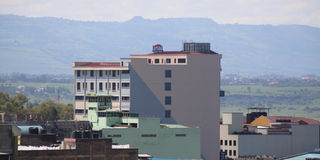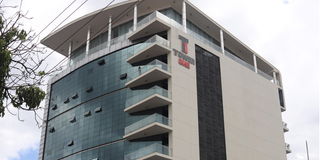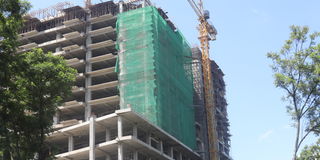Fissure below, towers above: Geologists question Nakuru’s rapid growth

Jamaa Business Complex along Oginga Odinga road. It is among Nakuru's top tall buildings, counting more than the recommended four stories .Photo taken on May 15,2025.
In recent years, Nakuru’s skyline has begun to shift dramatically. Iconic new structures such as Tower One, Jamaa Business Complex, Golden Life Mall, and the 12-storey CK Patel building are changing the face of the city.
Even more striking are the high-rise developments underway near the Nakuru Athletic Club and close to State House proof that the city is building upward at a rapid pace.
But what changed?
For decades, urban planners and geologists recommended that Nakuru restrict buildings to no more than four stories. This was not just caution, it was grounded in science.

Tower 1 which is currently considered the tallest building in Nakuru boasting 14 floors. Photo taken on May 14,2025.
A report developed by a seismologist from KenGen, Cyrus Karingiti, and Kizito Opondo, together with a geologist from GDC, Eng. Paul Ngugi revealed Nakuru seats on a major fault line along the Rift.
The city is on a geologically fragile landscape, riddled with underground cavities, volcanic activity remnants, and a documented history of sinkholes , with recent once happening in Kaptembwo, London , Kiamunyi, Gilgil , shabab, Ngata among other areas.
Yet today, Tower One rises 14 floors into the sky, and CK Patel reaches 12. This trend isn’t limited to commercial properties.
High-rise residential complexes are also climbing higher than ever before. Hyrax Apartments, Kwanza courts and Memento Apartments, both standing at seven, six and five stories respectively.
This marks a bold shift in Nakuru’s urban housing strategy. More and more, developers are opting to build upward to meet the city’s growing demand for housing and office space.
To understand this shift, Mtaa Wangu speaks to Dr. Isaac Kanda, a Principal Geoscientist, working with Geothermal Development Company (GDC) and has studied Nakuru’s geology since 2006. He notes that there is a mismatch between current construction practices and the city’s complex geological makeup.
“Certain areas in Nakuru have unstable subsurface conditions, including loose soil and underground cavities. These geologic features make them particularly vulnerable to structural failure, especially during heavy rains or seismic events,” he says.

A new building under construction near the Nakuru Athletic Club. Photo taken on May 15,2025.
During rainy seasons, runoff water exacerbates the risk by eroding soil and creating underground rivers that destabilize foundations. Without proper runoff management, these issues are likely to worsen, increasing the likelihood of building collapses.
Dr. Kanda emphasizes the urgent need for a city-wide geotechnical survey to evaluate the stability of various zones within Nakuru. This data should inform a detailed zoning map to guide construction, ensuring that only geologically stable areas are approved for taller buildings.
“A standardized requirement for geotechnical reports prior to any construction would allow the county to manage risks proactively and scientifically. In addition to regulating future development, existing buildings must also be reviewed for structural integrity and compliance with safety standards. This information would be vital not only for public safety but also for informing potential investors about where it is safe to build or buy property,” he recommends.
Dr. Kanda calls for a coordinated effort between the county and national government to implement these safety measures.
“These buildings may appear structurally sound, but the ground beneath is not. What we consider modern and ambitious today could become tomorrow’s disaster,” his warning clear and stark.
What’s your take on this?


